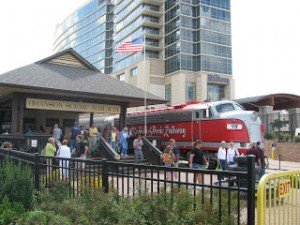The History of Branson Missouri
Like many other towns, Branson had it’s beginnings in 1882 with the establishment of a general store. The town is named for Reuben Branson who not only opened the general store but also operated it as the local post office.

The start of Branson as an entertainment town actually began in 1894 with the Marvel Cave. This was a natural cave explored in the 1880’s and it was found to house quite a lot of marble.
The Marvel Cave was eventually purchased by a man named William Lynch and he opened it up to tourists. Lynch’s tourist business did quite well. The town of Branson grew and was incorporated in 1912.
Branson Missouri has become a premiere tourist destination for many families. The list of Branson attractions is long. Many people travel to Branson because of the first class entertainment available in such a beautiful setting with plenty of outdoor recreation.
You will find more than fifty live performance theaters, a whopping twelve championship golf courses, three beautiful lakes, an international award winning theme park, a very historic downtown district and an excursion train that will take you on a pleasant short trip into northern Arkansas and back.

A Popular Tourist Destination
Branson, located in the scenic Ozark Mountains of southern Missouri, bills itself as a very affordable family vacation destination, and it truly is. There is something in Branson for the entire family. The town offers some 22,000 hotel rooms and a huge selection of restaurants that will fit any budget. It’s estimated that Branson receives some 7 million visitors per year. There are about 100 live shows and a total of 400 restaurants.
A family will find hotels in Branson Missouri to fit every vacation budget. You’ll also find several Branson vacation packages to fit just about any trip length. You’ll also want to check out the resorts in Branson Missouri, some of which offer cabins, marinas and boat rentals. Branson resorts also offer vacation packages.
For many years Branson was a popular destination for travelers from Missouri and other nearby states. A big change occurred with the establishing of music theaters by nationally known performers. These theaters found all along Highway 76 ( known as The Strip) greatly increased Branson’s popularity and as a result Branson Missouri is a destination for tourists from all areas of the United States and the world. Branson shows are one it’s main attractions.

Branson Scenic Railway
During my visit to Branson I took the Branson Scenic Railway on it’s very enjoyable one hour and 45 minute trip. The trip begins at the train depot in the center of town near the river.
The train travels through tunnels, over trestles, and through the southwest Missouri and northwest Arkansas wilderness. The Ozark Mountain foothills offer terrific picture taking opportunities. The train is made up of unique passenger cars. If you love trains then you’ll love this fun rail excursion. The excursion is a forty mile round trip and snacks are available onboard.

Plenty of Golf in Branson
Golf is another one of the popular things to do in Branson. If you’re a golfer, your Branson vacation will offer a fine selection of golf courses for any skill level. I was able to play several during my trip there.
The Ozark Mountain topography lends itself well to championship golf courses. In addition to this, while winter does make it’s way to Branson each year, the climate at Branson is mild most of the time. There are more than six major golf courses in Branson and three popular ones are Thousand Hills, Branson Creek and Pointe Royale.
See the Trips Into History articles on the links below…
Texas Railroads and Historic Train Depots
Travel the Meeting of the Great Rivers Scenic Highway
Branson Centennial Museum
The Branson Centennial Museum shares the stories and legacy of Branson. The museum teaches the areas culture to future generations. Featured are rotating displays that change about every six to eight weeks. The museum is located at Main Street and Veteran’s Boulevard in down town Branson.
Enjoy the free discovery trolley in Historic Downtown Branson which can take you to the museum, the riverfront area and the scenic railway depot.
Getting to Branson
Branson is a perfect family vacation destination and depending on where you happen to reside, it’s one of the best weekend side trips you can find anywhere. Branson attractions offer something fun for every family member.
Located near the center of the country along the beautiful Ozark Mountains, Branson is less than a day’s drive for one-third of Americans.
Branson is located in extreme southern Missouri about 50 miles south of Springfield Missouri very near the Arkansas border. It’s about 220 miles from Tulsa Oklahoma mostly via Interstate-44. About 200 miles from the Kansas City area and about 155 miles from Fort Smith Arkansas.
Airports that serve Branson include the Branson Airport and the Springfield-Branson National Airport.
(Article and photos copyright 2014 Trips Into History)
